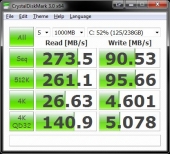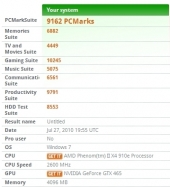Testing, Continued
CrystalDiskMark
Written primarily by a Japanese fellow who styles himself “hiyohiyo”, CrystalDiskMark is a simple, straightforward way to test the performance of your drives. It runs the drive through read and write tests of your choice of random data, all 0’s, or all 1’s. For this test, we left it at the default of 5 passes, 1000MB file size.
Sequential read and write were quite rapid, though neither came close to the numbers Crucial has claimed. The write speed falls particularly short, coming in at 90MB/sec versus the “up to” 215MB/sec claimed. Performance was about the same for the 512k cluster test, with read speed going down a bit and write speed going up.
The 4k cluster test is particularly telling, with read speed falling to 26MB/sec and write speed falling to 4.6MB/sec—numbers that compare unfavorably with some hard drives. The 4k test run at a queue depth of 32 offered some startling improvements on read speed, though again write speed was dismal.
Datamarck
Datamarck is another no-nonsense benchmark; pick a drive, press start, and it gives you comprehensive performance results. Since there were no options to configure, let’s jump straight to the analysis.
Performance with Datamarck was somewhat worse than the others; this is not unusual, as Datamarck uses a more aggressive dataset for testing. Again, read performance was mostly uniform across the drive, with an average speed of 216MB/sec. Access times showed a bit of a spike at the beginning, though performance was still quite excellent with a peak of 0.5ms.
PCMark Vantage
The value of PCMark Vantage is debatable, since it doesn’t provide any objective performance numbers in its results. Nonetheless, more “PCMarks” indicates a better system, in some nebulous way, so we went ahead and ran the RealSSD equipped test system through its paces.




[…] Quote: Slow secondary storage has been the biggest persistent gripe about PC gaming for quite a while now. While CPUs, RAM, graphics cards and system busses have all been improving at a steady rate; hard drives have stayed more or less stagnant for the past decade. Enter the solid state drive. At its most basic level, a SSD has the same basic structure as a USB flash drive: a bunch of NAND flash memory chips, a controller to tie them together, and an interface that talks to the outside world. Where a SSD pulls ahead is, naturally enough, in the performance of those three components. Today we’ll be looking at the RealSSD C300 256GB SSD from Crucial. Taking advantage of the still-uncommon SATA 6.0 GBps interface, this drive promises to deliver blisteringly fast performance. LINK: http://www.techwarelabs.com/crucial-realssd-c300-256gb/ […]
[…] Quote: Slow secondary storage has been the biggest persistent gripe about PC gaming for quite a while now. While CPUs, RAM, graphics cards and system busses have all been improving at a steady rate; hard drives have stayed more or less stagnant for the past decade. Enter the solid state drive. At its most basic level, a SSD has the same basic structure as a USB flash drive: a bunch of NAND flash memory chips, a controller to tie them together, and an interface that talks to the outside world. Where a SSD pulls ahead is, naturally enough, in the performance of those three components. Today we’ll be looking at the RealSSD C300 256GB SSD from Crucial. Taking advantage of the still-uncommon SATA 6.0 GBps interface, this drive promises to deliver blisteringly fast performance. LINK: http://www.techwarelabs.com/crucial-realssd-c300-256gb/ […]
[…] Quote: Slow secondary storage has been the biggest persistent gripe about PC gaming for quite a while now. While CPUs, RAM, graphics cards and system busses have all been improving at a steady rate; hard drives have stayed more or less stagnant for the past decade. Enter the solid state drive. At its most basic level, a SSD has the same basic structure as a USB flash drive: a bunch of NAND flash memory chips, a controller to tie them together, and an interface that talks to the outside world. Where a SSD pulls ahead is, naturally enough, in the performance of those three components. Today we’ll be looking at the RealSSD C300 256GB SSD from Crucial. Taking advantage of the still-uncommon SATA 6.0 GBps interface, this drive promises to deliver blisteringly fast performance. LINK: http://www.techwarelabs.com/crucial-realssd-c300-256gb/ […]
[…] Quote: Slow secondary storage has been the biggest persistent gripe about PC gaming for quite a while now. While CPUs, RAM, graphics cards and system busses have all been improving at a steady rate; hard drives have stayed more or less stagnant for the past decade. Enter the solid state drive. At its most basic level, a SSD has the same basic structure as a USB flash drive: a bunch of NAND flash memory chips, a controller to tie them together, and an interface that talks to the outside world. Where a SSD pulls ahead is, naturally enough, in the performance of those three components. Today we’ll be looking at the RealSSD C300 256GB SSD from Crucial. Taking advantage of the still-uncommon SATA 6.0 GBps interface, this drive promises to deliver blisteringly fast performance. LINK: http://www.techwarelabs.com/crucial-realssd-c300-256gb/ […]
[…] This post was mentioned on Twitter by ChrisTWL, tcpflorida, Josh, Cory Blomenkamp, Tom Gowing and others. Tom Gowing said: Review: Crucial RealSSD C300 256GB – http://www.techwarelabs.com/crucial-realssd-c300-256gb/ […]